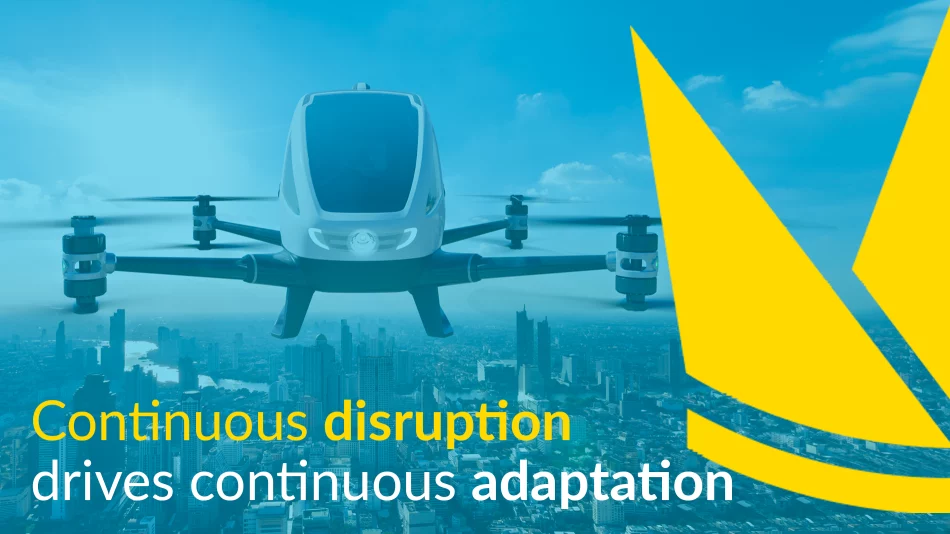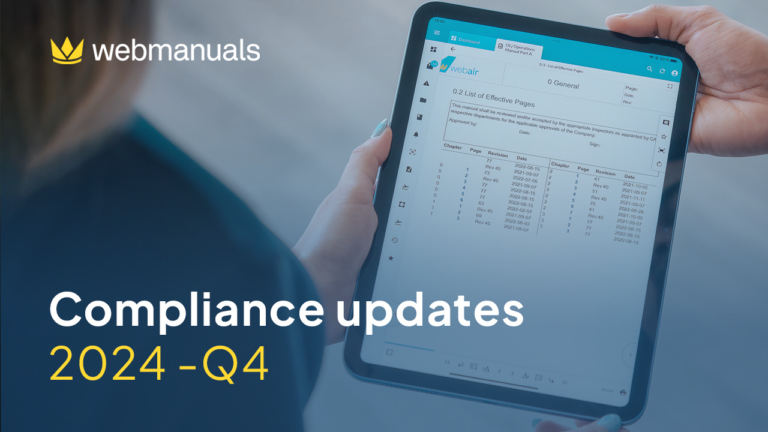By: Martin Lidgard
* Based on the presentation “Continuous disruption drives continuous adaptation” at the 11th Annual Aircraft Records Conference.
Progress, innovation, and evolution are based on change. The biggest transformations in history originated due to disruptive events that pushed a change. The beginning of genetic modification, the development of artificial intelligence, or the origins of big data started from disruptive events that pinned a milestone in the history of humanity.
A look into recent history shows us that both major catastrophic events and breakthroughs are happening faster and faster. We are living in an acceleration of technical, political, and environmental evolution that requires us to adapt to new tools, systems, and conditions.
Nowadays, adaptation is a must.
The changes we have experienced in recent years have shown us, once again, that transformation is key to withstand in current society. We have witnessed that survival relies on the ability to adapt quickly to the unexpected.
During the pandemic, we were hit by an avalanche of events that disrupted life as we knew it. In a few weeks, we faced challenges as a society that led us to adapt from micro to macro levels and forced us to find a way to align it to the new reality.
Certainly, aviation was a seriously impacted industry. Bans between countries appeared, the operations ceased and we saw how air transport in the world was paralyzed like never before. Passengers traffic and revenue dropped in just a couple of weeks. The data is not encouraging and shows us a scenario in which many companies have suffered significant losses and many others are on the road to recovery recurring to urgent actions.
Both the need for immediate action and a strategic mindset is determining enterprises’ survival during and after the crisis. Adaptability, once again, is the key performance indicator that summarized the vital factor in the survival game.
Unfortunately, it looks like we are not done yet. As we see the world is slowly adapting and reshaping to the new conditions, extraordinary circumstances arise. Now we have to face a scenario of geopolitical tension seriously affecting the already weak global economy, dropping the stock market, and rising gas prices – which all directly impact air operators.
Uncertainty is back on track, and a new plan must be in place to respond to the new disruptive incidents. Because a careful review of recent history shows that a series of massive chaotic events will continue to happen. We have reached a new normal of continuous disruption.
Then, the ability to modify plans flexibly and favorably can make the difference between successful organizations and those that unfortunately have -and will- succumb to adversity.
The key lies in the correct attitude towards changes. Research at London Business School shows that 9 out of 10 companies that see disruption as a threat, go under. Strangely enough, the same numbers seem to apply to companies that approach disruption as an opportunity.
When looking at those that thrive, they address disruption as both a threat and an opportunity. They combine urgency and strategy.
Understanding disruptions as urgent challenges and at the same time as opportunities for positive transformation is what defines a successful company. This allows to be in constant innovation and gives a strategic advantage in today’s market.
Let’s take an example. SmartLynx was a stable and respected airline providing full charter operations since 1992. Their expansion and sustainable growth were disturbed by the pandemic. Like most airlines, they suffered substantial losses in passenger flow at the beginning of 2020.
However, their story took an interesting turn when they made the decision to diversify their fleet by adding air cargo to their portfolio. Their forward-thinking business model transformation solved a problem that had downsized many other companies. Taking a closer look at this example, we appreciate that the implemented plan not only allowed to solve the imminent situation but is also scalable and sustainable in the future.
For this strategy to work, SmartLynx articulated the immediacy to respond to the situation and the awareness of making an analytical decision. Here we see again urgency and strategy combined to take disruptions into innovative actions.
They were able to respond efficiently to the urgent situation because they were prepared with our software that allowed them to be flexible and quickly adapt the new fleet. With our compliance software, they were able to develop, implement and regulate the operations adjusting to the new strategy. One of the main advantages that helped them transform efficiently was the ease of staff training to stay compliant with new aviation regulations, even though their employees had to be trained remotely.
We had the opportunity to closely follow their diversification process and we saw how they added value to their clients and employees with new services vital for the world situation. The impact has been very positive and continues to thrive after two years. Just a couple of weeks ago they announced the growth of their team and the expansion of their fleet with Boeing 737 MAX.
We see an upstanding pattern among our customers.
ACMI operator CityJet in Dublin implemented Web Manuals in 2017, speeding up document authoring, compliance, and distribution. Web Manuals has become the solid foundation that enables quick changes and a connected crew.
When the pandemic hit, they had to reduce their team from 1200 people to only 100. Now that operations are picking up again, there’s a new landscape for CityJet. Their lead times have significantly decreased, and airlines are expecting CityJet to adapt much more quickly.
Additionally, flying to new destinations requires assessment of new airfields and this can be immediately implemented in the OM-C and delivered to crews instantly.
It is time to ask ourselves what we are doing to prepare for the future, and how we are going to respond to the next disruptive event. Global organizations are creating various scenarios with different challenges to develop flexible contingency plans anticipating what may happen.
Because if we are sure of something, it is that this is the standard now. We must prepare ourselves to constantly adapt to extreme conditions of continuous change. We have to learn to live, work and progress in a world of permanent turbulence.
One clear lesson we’ve learned is that adapting quickly is critical to remaining in force. It is becoming increasingly important to be in sync with the technological revolution that is briskly transforming the world. Because the adaptability of the growing technology in every business is determining the survival of the organizations.
The accelerated progress of technology is promptly replacing systems, devices, and structures while increasing the efficiency of processes and business development. Technology has become the fundamental vehicle that eases the successful adaptation of companies.
At Web Manuals, we experience it daily. For 10 years we have seen how our aviation compliance software has been the transforming solution for hundreds of companies that have embraced change. Our software allows them to be up to date and in control of critical documentation processes, which gives them a strategic advantage when adjusting to the abrupt circumstances that are -and will continue- happening.
It is necessary not to act reactively based on fear but rather proactively driven by strategic thoughts. Just as SmartLynx, Svenskt Industriflyg, and many others have thrived by developing constant actions to adapt to a non-stop disruptive world.
Paramount political, economic, and technological events are happening now. The highly turbulent picture is both encouraging and bleak. Adaptability is the only option – preparing ourselves to adaption is the only way to survival.




